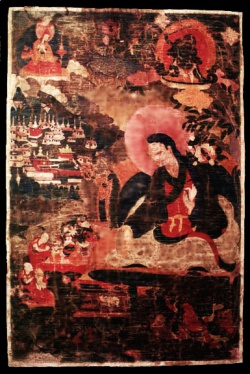Bromdon Chorje
By Tom Suchan
26 May, 1998
The ordained layman Bromdon was the principle Tibetan disciple of Atisha (d.1057) who initiated the second propagation of Buddhism in Tibet. Bromdon, the main figure of the painting, founded the Kadam sect, the first of the "new" schools of Tibetan Buddhism. The fierce Achala appears above Bromdon and is also connected with Atisha who is himself represented in the upper left corner. In the lower right corner is a form of Mahakala, the "great protector" of Buddhism, who was also introduced into Tibet by Atisha. The buildings may represent the Ratreng Monastery founded by Bromdon in 1057.
The famous ordained layman (S: upasaka) Bromdon (1005-1064) was the principle Tibetan disciple of the Bengali master Dipamkara Srijnana (982-1057), better known by the honorific title Atisa, "The Incomparable One." Atisa was one of the most famous Indian scholars of his day and is credited with providing the impetus to initiate the second propagation of Buddhism in Tibet with his arrival at the request of the western Tibetan king Yeshe-O in 1042. Near the end of Atisa's intended stay of three years, Bromdon meet Atisa and convinced him to remain in Tibet for the remainder of his life. Bromdon became Atisa's primary disciple and a noted scholar and translator in his own right. After Atisa's death, Bromdon founded the Kadam (T: bKa' gdams) sect of Tibetan Buddhism to continue the teachings of Atisa. Led by Dromdon's example the Kadampas were famous for their devotion and strict discipline (Lopez, 20). The Kadam sect was influential to all the "new" (T: gSerma) sects of Tibetan Buddhism and later gave offspring to the Gelug sect which is sometimes referred to as the New Kadam sect.
Bromdon is shown seated on a raised dias with a heavy bolster in front of a flowering Hibiscus tree. The large lotus spring he holds in his left hand is the primary attribute of the Bodhisatva Avalokiteshvara who is the spiritual source of Bromdon. His long hair and colorful garments indicate his status as an ordained layman. Below in front of Bromdon is an altar with various offerings and two monks, one bowing in respect and the other making an offering to Bromdon. Receding in the background behind the monks is a small vignette of a monastery that is surrounded by a number of kadam style chortens, a form of stupa said to have been introduced in Tibet by Atisa. Undoubtedly, this monastery is intended to represent Ratreng (T: Ra sgreng) Monastery located in central Tibet which was founded by Bromdon in 1057 following Atisa's instructions. The faintly visible silver chorten in the center of the monastery complex and partially obscured by the surrounding buildings may be a reference to the silver caitya used by Bromdon to contain a portion of Atisa remains (see Chattopadhyaya, 439; and, Tucci, 89). Atisa himself is represented in the upper left corner directly above the monastery. Atisa can be easily identified by his usual attributes; a small gold kadam style stupa on his right, and food offering bag on his left. The placement of Atisa above the monastery is a symbolic statement of the continuation of the teaching reforms led by Atisa through his selected successor Bromdon and the monastic system he helped establish.
Other elements in the painting are also connected with the teachings of Atisa. In the lower right corner of the painting is a group of three fierce deities. The large central red figure is a form of Mahakala called "the chopper (welding) Red Mahakala of the Southwest" (T: lHo Nub mGon Po Gri Gug dMar po), said to have been introduced to Tibet by Atisa ( De Nebesky-Wojokowitz, 54). The figures to his sidea are his two companions, the goat-headed "Yaksa the butcher" (T: Yaksa bShan pa) and the red goddess "Mara the heart-eater" (T: Mara sNying za ma). Another fierce two armed deity appears above Bromdon in the upper right corner of the painting. This blue colored figure can be identified by his attributes, a sword and lasso, as Mahacandarosana an emanation of the Buddha Vairocana, better known as Acala (T: Mi Gyo ba ). The Kadam sect is particularly noted for their devotion to Acala (Tucci, 89). The form of Acala represented in this painting is probably a form known as "The Blue Acala of the Kadam Sect" (T: Mi Gyo ba sngo bo dKa gDams Lugs) that is associated with Bromdon's mentor Atisa.
The overall composition of the work is similar to a standardized format used in depictions of famous Tibetan teachers done under the patronage of the Qing court of China. An almost exact duplicate of this painting is part of a set of thirteen tangkas dated to the Qianlong era (1736-1795) that depict the first seven Dalai Lamas and other Tibetan incarnations of Avalokiteshvara, and was once hung in the Qing Imperial Palace in Jehol (see Toni Schmid, 24). This painting of Bromdon was probably part of a similar set created at the Qing court and perhaps given to a visiting Tibetan dignitary. The painting differs from the work reproduced by Schmid only in details of the secondary figures and landscape indicating that both may have been reproduced from the same woodblock print blueprint but painted by different artists.
References:
Gilles Beguin. Tibet, Art et Meditation Ascetes et Mystiques au Muse Guimet-exposition. (Paris: Editions Findalkis, 1991).
Alaka Chattopadhyaya. Atisa and Tibet. (Calcutta: Motilal Banarsidass Publishers, 1967).
Rene De Nebesky-Wojokowitz. Oracles and Demons of Tibet. (the Hague, Mouton and Co, 1956).
Hubert Decleer. "Atisa's Journey to Tibet." in Religions of Tibet in Practice. Donald S. Lopez, Jr. (Editor) (Princeton: Princeton University Press, 1997).
Donald S. Lopez, Jr. (Editor) Religions of Tibet in Practice. (Princeton: Princeton University Press, 1997).
Marilyn M. Rhie, Robert A.F. Thurman. Wisdom and Compassion. (New York: Harry N. Abrams, 1991).
Guiseppe Tucci. Tibetan Painted Scrolls. (Rome: La Liberia Dello Stato, 1949).
Toni Schmid. Saviours of Mankind. (Stockholm: Staten Etnografiska Museum, 1961).
